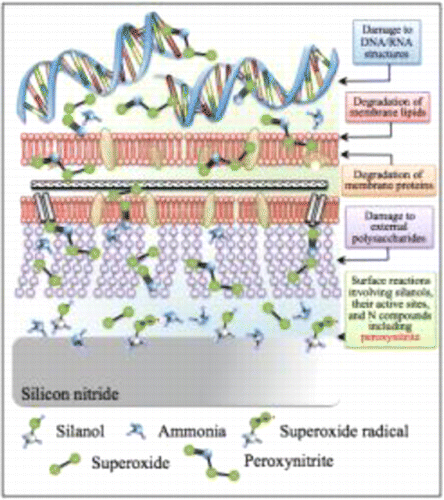How bioceramics could help fight gum disease

Severe gum disease known as periodontitis can lead to tooth loss, and treating it remains a challenge. But new approaches involving silicon nitride, a ceramic material used in spinal implants, could be on the way. The surface of silicon nitride has a lethal effect on the bacteria that commonly cause periodontitis. Now scientists, reporting in ACS' journal Langmuir, are examining why this happens. Their findings could help inform future efforts to treat the disease.
About half of American adults have some form of gum disease. It's caused by bacteria that infect the tissue around teeth, resulting in gum inflammation. If the condition progresses, the bacteria can damage the bone that supports the teeth. In addition to tooth loss, periodontitis can increase a person's risk of heart attack or stroke. Options for treatment include scaling and root planing, topical antibiotics and surgery. Giuseppe Pezzotti and colleagues wanted to find a new alternative by studying the reactions of bacteria to antimicrobial silicon nitride.
The researchers investigated how the ceramic material changes the metabolism of Porphyromonas gingivalis—the bacteria species primarily responsible for periodontitis. They found that chemical reactions at the surface cause the bacteria's nucleic acids to degrade and drastically reduce the amounts of certain proteins and fats. While further studies are needed, the results show silicon nitride holds promise as a therapeutic aid for treating severe gum disease.
More information: Giuseppe Pezzotti et al. Silicon Nitride Bioceramics Induce Chemically Driven Lysis in , Langmuir (2016). DOI: 10.1021/acs.langmuir.6b00393
Abstract
Organisms of Gram-negative phylum bacteroidetes, Porphyromonas gingivalis, underwent lysis on polished surfaces of silicon nitride (Si3N4) bioceramics. The antibacterial activity of Si3N4 was mainly the result of chemically driven principles. The lytic activity, although not osmotic in nature, was related to the peculiar pH-dependent surface chemistry of Si3N4. A buffering effect via the formation of ammonium ions (NH4+) (and their modifications) was experimentally observed by pH microscopy. Lysis was confirmed by conventional fluorescence spectroscopy, and the bacteria's metabolism was traced with the aid of in situ Raman microprobe spectroscopy. This latter technique revealed the formation of peroxynitrite within the bacterium itself. Degradation of the bacteria's nucleic acid, drastic reduction in phenilalanine, and reduction of lipid concentration were observed due to short-term exposure (6 days) to Si3N4. Altering the surface chemistry of Si3N4 by either chemical etching or thermal oxidation influenced peroxynitrite formation and affected bacteria metabolism in different ways. Exploiting the peculiar surface chemistry of Si3N4 bioceramics could be helpful in counteracting Porphyromonas gingivalis in an alkaline pH environment.
Journal information: Langmuir
Provided by American Chemical Society

















